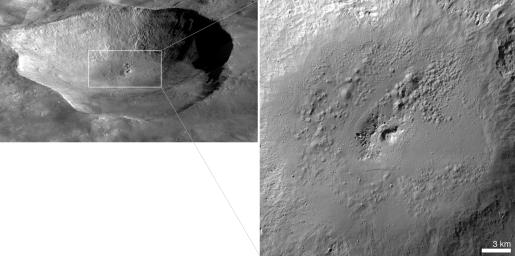
|
Most Spectacularly Preserved Pitted Terrain on Vesta
- Click the image above for a larger view
- Full-Res JPEG (3085 x 1533) (726.7 kB)
- Full-Res TIFF (3085 x 1533) (4.7 MB)
Caption:
This perspective view of Marcia crater on the giant asteroid Vesta shows the most spectacularly preserved example of "pitted terrain," an unexpected discovery in data returned by NASA's Dawn mission. This view is a mosaic of images from Dawn's framing camera, overlain on a digital terrain model with five times vertical exaggeration.
At right is a close-up of the floor of Marcia, which contains the largest concentration of pits on Vesta. Marcia is one of the youngest craters on Vesta, with a diameter of about 40 miles (70 kilometers).
Scientists think low-speed collisions with carbon-rich meteorites left hydrated minerals on Vesta's surface. It is thought that heat generated during later, high-speed collisions with asteroid belt rocks released water that was previously bound within the hydrated minerals. This water is thought to have explosively degassed into space, leaving behind pothole-like depressions as it escaped.
Background Info:
Dawn's mission to Vesta and Ceres is managed by JPL for NASA's Science Mission Directorate in Washington. JPL is a division of the California Institute of Technology in Pasadena. Dawn is a project of the directorate's Discovery Program, managed by NASA's Marshall Space Flight Center in Huntsville, Ala. UCLA is responsible for overall Dawn mission science. Orbital Sciences Corp. in Dulles, Va., designed and built the spacecraft. The gamma ray and neutron detector instrument was built by Los Alamos National Laboratory, N.M., and is operated by the Planetary Science Institute, Tucson, Ariz.
More information about Dawn is online at http://www.nasa.gov/dawn and http://dawn.jpl.nasa.gov .
Cataloging Keywords:
| Name | Value | Additional Values |
|---|---|---|
| Target | 4 Vesta | |
| System | Main Belt | |
| Target Type | Asteroid | |
| Mission | Dawn | |
| Instrument Host | Dawn | |
| Host Type | Orbiter | |
| Instrument | Framing Camera (FC) | |
| Detector | ||
| Extra Keywords | Collision, Crater, Grayscale, Water | |
| Acquisition Date | ||
| Release Date | 2012-09-20 | |
| Date in Caption | ||
| Image Credit | NASA/JPL-Caltech/UCLA/MPS/DLR/IDA/JHUAPL | |
| Source | photojournal.jpl.nasa.gov/catalog/PIA16182 | |
| Identifier | PIA16182 | |
